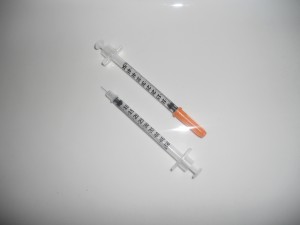 Once upon a time we only had long insulin needles. Of course they weren’t called long; they were simply called needles. But over the past several years the needles for injecting insulin (by syringe or pen) have gotten shorter and finer.
Once upon a time we only had long insulin needles. Of course they weren’t called long; they were simply called needles. But over the past several years the needles for injecting insulin (by syringe or pen) have gotten shorter and finer.
I remember counseling patients who were bigger to use longer needles and patients who were smaller to use shorter ones (if they wanted to). Then one day I was at a conference exhibit and saw a demonstration on skin thickness, which basically showed that shorter needles work for anyone.
Now even I use “short” needles, but I admit I haven’t gone to the shortest ones yet. The options start with 12.7 mm and move down to 8 mm, then 6 mm, 5 mm, and now even 4 mm (in other countries there may be other options).
Back in the day we used to teach people to pinch up their skin (fatty tissue, we called it). It turns out this was necessary in order to avoid injecting into muscle, which can lead to unpredictable insulin action times (usually too fast). We even told people who were extremely thin to inject at a 45-degree angle.
But now we have short needles (and shorter ones), so we no longer need to pinch the skin. In fact, pinching the skin with super short needles could lead to injecting into the dermis (skin) and not the subcutaneous tissue (fat). That would also affect the ability of insulin to do its job properly.
Here are some other interesting tidbits about needle length: men probably would benefit from needle lengths shorter than 8 mm; there tends to be more bruising with longer needles; and studies have shown absolutely no difference in blood glucose levels between the various length needles.
So enjoy your short needles!

